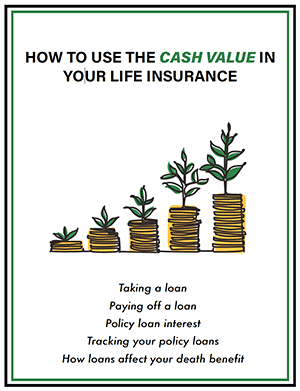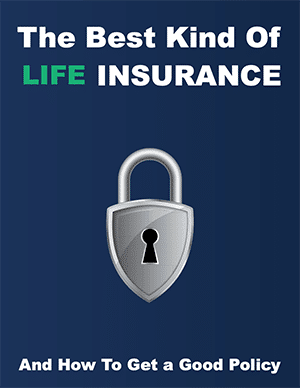702-660-7000
702-660-7000
Learn about the pros and cons of different kinds of life insurance policies, how they are designed, and how they work.
After watching the video above or reading the synopsis below, you will know more than the average life insurance agent about how life insurance works!
To understand how life insurance works, you’ll need to understand some key terminology:
Life insurance is an umbrella term for many types of policies. There are two types of life insurance: term and permanent. Term life insurance policies are only for a certain time period—or a term of your life. Within term insurance, there are two types: one-year renewable term and level term. Permanent life insurance covers you until you die, so you’re guaranteed the death benefit as long as you keep your policy inforce. Within permanent life insurance, there are two types: whole life and universal life. We’ll break down each of these types of life insurance and explain how they work.
If you buy a one-year renewable policy when you’re young and healthy, chances are you’ll get a low premium. However, it’s important to know that you have to renew this policy every year if you want to keep the coverage going. When you renew a one-year renewable term life insurance policy, your premiums will change too and they won’t be going down! By the time you reach an age when you’re likely to die, your premiums will be sky high compared to what they once were.
Why do your premiums increase? As you get older, you’re more likely to die. When there’s more risk that you’ll die, there’s more risk for the insurance company because it becomes more likely they will have to pay your death benefit. To counter this risk, insurance companies require higher premiums. Because of the way one-year renewable term works, it is financially difficult to maintain this type of policy over time. As with any insurance policy, the policy must be kept current. If you die outside the coverage period, your beneficiaries receive nothing.
Level term life insurance also only covers a certain period of your life, but these policies have a “level” premium. You won’t be paying a rising premium every year. How does this life insurance work? The insurance company will average what you’d pay for the entire coverage period, and they’ll create a level premium amount—often with a discount. You can choose a term that is 10, 15, or 20 years, sometimes even 30, years-long, depending on what you need.
Some level term insurance policies also have a convertibility feature. Convertible term allows you to take a term insurance policy and convert it into a whole life insurance policy. If you eventually want permanent coverage, or the ability to obtain permanent coverage at the health rating you received when first purchasing the term policy, it’s important to choose level term insurance that can be converted to whole life insurance. When you choose to convert a term policy to whole life, you get to keep the same health rating from your original term policy or get a better rating if your health has improved. For example, if you get a 10-year convertible level term insurance policy when you’re young with a super preferred rating, you get to keep that super preferred rating when you convert to whole life, even if you have had a decline in health.
Universal life insurance is classified as permanent life insurance, but there is much argument about whether it is actually permanent or not. Premiums paid for universal life insurance will go to buy death benefit by purchasing renewable term insurance within the universal life insurance policy. The remainder of premiums, after expenses have been deducted, will be put into an account that is credited with an interest rate, or in the case of variable universal life, invested, or in the case of indexed universal life insurance, mirrors an index. In theory, the cash value is supposed to grow enough over the years to offset increasing premiums on the renewable term portion of the universal life policy. So theoretically, your death benefit never expires.
All of this sounds nice, but universal life insurance treats the insurance company better than it treats the policyholder. Because of how universal life insurance is designed, it transfers the risk back to the policyholder when the insured is more likely to die. Since most of these policies do not earn enough money to offset rising premiums, many people lose their universal life insurance policies when they become too expensive to pay.
The major reason universal life insurance can become too expensive is because the death benefit is supplied by one-year renewable term insurance. As the premiums for the renewable term insurance increase, the insurance company will dip into your cash value to make up any difference in the premium you pay and the premium required. This could be fine and dandy if the cash value is keeping up or pulling ahead of rising premiums, but woe to the person whose cash value doesn’t earn enough to keep up with renewable insurance premiums. They will find themselves forced with the decision to pay significantly higher premiums or lose their policy and the associated life insurance coverage!
Whole life insurance is the other type of permanent life insurance, and arguably the only true permanent life insurance. You’re guaranteed a death benefit with whole life insurance as long as you keep your policy inforce. With whole life insurance, you’ll have a set premium that isn’t going to increase as you age.
Whole life insurance builds cash value that is similar to building equity in a home. The longer you own a whole life insurance policy, the more cash value you will have. You can use cash value from a whole life policy in various ways while you are alive. Cash value is one of the living benefits of whole life insurance.
 | Tools of the Trade - How to Use the Cash Value in Your Life Insurance A quick reference guide on how policy loans work, how to make loan repayments and how to track your loans. |
Many whole life policies also have the option to include a paid-up additions rider. With a paid-up additions rider, you can have cash value available in your policy right away. Basically, your death benefit increases with the paid-up additional insurance, so your cash value increases also.
Participating whole life insurance, is a slightly different animal than just plain whole life insurance. Participating whole life insurance allows the policyholder to participate in the earnings of the insurance company. Generally, participating policies will only be offered by a mutual company as opposed to a stock-held company. When mutual companies earn a profit they share the profits with all the owners in the company. If you own a whole life insurance policy with a mutual company, you’re technically an owner of the company, therefore you share the company’s profits in the form of a dividend. One of the dividend options is the purchase of additional death benefit which increases the cash value of the policy.
Whole life insurance is our favorite type of policy because your premiums are fixed, you have a guaranteed death benefit, and you’ll have guaranteed cash value accumulation that you can use while you’re alive. We don’t have any complaints about whole life insurance that pay dividends!
 | Get a working knowledge of how each type of life insurance policy works. After reading this 10-page booklet you'll know more about life insurance than most insurance agents. Download here> |
Commissions for life insurance agents work differently than commissions for real estate agents or car salesman. When you buy a home, a portion of the money you pay goes to the agent. For life insurance, the money you pay goes directly into your policy. The insurance company has a general fund they use to pay expenses to run the company. This includes paying commissions to their agents.
Insurance agents that sell products with the least amount of risk for the insurance company get the highest commissions because policies that expose the insurance company to lower risk are preferred by the insurance company. Term and universal life policies pay comparatively higher commissions because the risk that a death claim will need to be paid out is smaller. Unfortunately, it can be tough to find an insurance agent who is willing to reduce their commission to design policies that are better for the consumer.
Anyone who has liabilities or potential liabilities that are greater than the liquid cash they have on hand “needs” life insurance. But life insurance itself is all about transferring risk away from yourself to a company that is willing, for a price, to assume that risk for you. There are many financial formulas designed to determine if an individual needs life insurance coverage, how much they need, and when they won’t need it anymore, but at the end of the day, many risks are unknown, so even though an individual may not “need” life insurance based on a financial formula, they may still want it for peace of mind.
Some people may think only the major income earner of a family needs life insurance. But even a non-employed spouse can add economic values. If a spouse who stays at home to take care of children should die this could be a crippling financial event to the family in terms of childcare, household activities, not to mention final expenses, and other expenses associated with the loss of a loved one.
An easier question to answer is: Who doesn’t need life insurance? The answer to this question is easy, people who are already dead.
Some people only buy term life insurance in their younger years and plan to “not need” life insurance by the time they will have, hopefully, paid off their house and all their children have grown. But if something happens along the way like sickness or disability, or God forbid the re-dependence of a child through catastrophe, some people may “need” life insurance after their term insurance has expired. By not buying permanent insurance earlier in life, but only term, they may have cut off their option to continue to have life insurance at this point because even if they are still insurable, health-wise, the premiums on a new policy may be unaffordable.
It is better to have life insurance and not “need” it than to need life insurance and not be able to have it!
How do you choose a life insurance policy? Different types of life insurance work for different situations. If you’re young and healthy and looking for the cheapest life insurance for a limited time, level term insurance may be the way to go. If you’re looking for consistent coverage with the opportunity to grow sustainable wealth and build a financial legacy through your cash value, whole life insurance is the best option.
At McFie Insurancewe design policies that help people grow their wealth and have financial peace of mind. Schedule an appointment if you need to get life insurance or have questions answered. It would be a pleasure to help you.